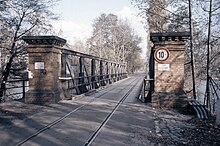Eiswerder
| Eiswerder | |
|---|---|
| Eiswerder Island (center) | |
| Waters | Havel |
| Geographical location | 52 ° 32 '56 " N , 13 ° 13' 7" E |
| length | 600 m |
| surface | 14 ha |
Eiswerder is the name of an island in the Havel , north of the Spandau Citadel . The island is connected by two road bridges with the east bank over the Small Eiswerder Bridge and the west bank over the Great Eiswerder Bridge. To the northeast is the Pioneer Island, a small, uninhabited, overgrown island that is under nature protection.
The area belonged to the Spandau manor district until 1910, after which it was incorporated into the city of Spandau .
Geographical location
The island is 140,000 m². The part of the Havel located west of Eiswerder is the federal waterway here . The bulge of the Havel east of the island is called Spandauer See and is only navigable for small pleasure craft.
About half of the island is forested. The buildings in the southern part of the island do not follow the building line of the Spandau bank development, but rather the axis of the citadel rotated by 45 °.
history
Before 1746 the island belonged to the Spandau office. In 1746, the Styrian transmigrant Philipp Schupfer received the desolate island of Eiswerder to settle on royal orders. 1817 was a secret in the Spandau Citadel fire missiles - laboratory furnishings. However, it moved to the Eiswerder as early as 1829, on which the military treasury had built a royal fireworks laboratory since 1826 .
Armourers
The island of Eiswerder with its armaments factories developed into an important military location in the 19th century . A powder factory , a gun foundry , an artillery workshop , a cartridge factory and an ammunition factory were located on it . In 1890, a chemical factory was established at Salzhof, northeast of the island of Eiswerder , which produced the acids for ammunition production. The armament systems were connected in 1892 via a 31 meter railway bridge (Kleine Eiswerderbrücke, opened for motor vehicles after the Second World War ) over the Havel to the Spandau Hamburger Bahnhof of the Berlin-Hamburger Bahn . In 1908 the track to the west of Nonnendammallee was connected to the Siemens freight railway and continued to the Berlin-Ruhleben station; the connection to the Hamburger Bahnhof (1911–1936: Spandau Hauptbahnhof , since 1998 Stresow station ) was given up in 1910 when its facilities were raised. To the acid plant at Salzhof led a siding .
Some narrow-gauge works railways existed within the companies, and tracks with a gauge of 600 mm were still in place on Eiswerder until 1986. In order to reduce the risk of explosion , fireless steam storage locomotives were used on these routes .
→ See also: Spandau military railway
Use after 1945
After the Second World War , the remaining halls and areas on the Eiswerder served as storage and transshipment points for grain, while tank farms were built on the Salzhof . From 1953 to 1990 the West Berlin Senate stored the expanded Senate reserves here . The Rhenus AG & Co. KG built on the island a roundhouse and a service pit and took over in 1988 from here the management of the Siemens rail freight.
From 1950 to the early 1970s were in the premises of the former powder and munitions factory film studios of the film production company CCC Film of Artur Brauner . The Eiswerder also became the location of various boat clubs.
Latest development
In 1993, the development agency of the Wasserstadt Spandau converted the warehouse buildings of the Prussian powder factories into office use. Soon afterwards, gastronomy ( restaurants and discotheques ) and television studios established themselves here . Eiswerder is now a commercial location with a focus on art and media. The mixed and residential use has been increasing since 2010, and various projects are being established that use the existing monuments in new ways.
Web links
Individual evidence
- ↑ The Oranienburger suburb . In: Otto Kuntzemüller : Documented history of the city and fortress Spandau from the origins of the city to the present . Magistrat der Stadt Spandau, Spandau 1881, p. 25. - Online .
- ↑ Bodo Schulz, Michael Krolop: The private and works railways in Berlin (West), p. 101 ff
- ↑ CCC Film-Atelier - Insel Eiswerder at gr-photographie.de , accessed on November 16, 2014
- ↑ denk-mal EISWERDER13 gGmbH



